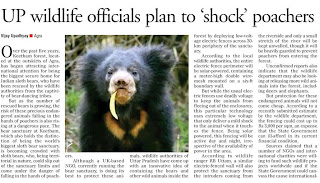Braj grudge: Lord Krishna's bank empty
Vijay Upadhyay
Agra. The "84-Kos" (250-mile) Braj region - spread around Agra, Bharatpur and Faridabad - is dotted with religious symbols and relics reminiscent of the era of Lord Krishna, 5,000 years ago.
However, while Christians in Jerusalem and Muslims in Mecca have preserved every symbol associated with Christ and the Prophet, relics that are a symbol of the Hindu heritage are being reduced to dust by some greedy stone mafia, who indulge in illegal blasting of hills in Vrindavan near Mathura.
Important relics like the Phisalini Shila and Khat Shila, where Lord Krishna had played and rested during his childhood, have become history. Many other heritage sites like the Vyomasur Cave where Lord Krishna is said to have killed the demon Vyomasur is caving in. Saugandhini Shila, where Lord Krishna pledged never to leave Braj, will soon be a thing of the past.
To prevent destruction of places testifying Lord Krishna's existence and establishing the authenticity of the Hindu scriptures, an organisation Braj Rakshak Dal, led by Vineet Narain, has taken up the task of restoring the former glory of Braj.
Mr Vineet Narain presented a report on the damage caused to religious sites caused by illegal blasting on Sunday in Agra. Mr Narain was there to garner support in favour of his campaign to protect the rich heritage of Braj.
He said out of 48 lush forests connected to raas leela, only 3 were left in their natural form. The rest had been reduced to barren land, their size varying from 5 acres to 350 acres.
Of a total of more than 1,000 ancient kunds, 80 per cent of them had been filled with silt,. Their carved chhatris and ghats were broken down. Of the 27 ghats of the Yamuna at Vrindavan, only one was left. Several heritage hills, bearing footprints of Lord Krishna in Braj, are being blasted by the stone mafia.
Mr Narain further said ever since the Braj Rakshak Dal took over protection of these sites, the threat of mining had come down but had not entirely stopped.
The organisation was not enough to stand as an effective barrier against mining thus making it necessary to recruit more volunteers and arrange extra funds to carry on with the restoration work.
According to Mr Narain, to facilitate future maintenance of the restored heritage sites and ensure community participation in developmental works, volunteers of the organisation were going to every village of Braj to mobilise the local community.
The Dal had restored 16 of the 1,000 historic kunds so far. But the organisation has only two earthmovers and needs 33 more to accomplish the job of restoring all the kunds of Braj in the next five years.


Comments